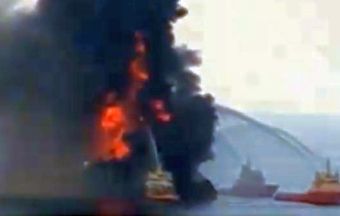
Publisher:
Bonnie King
CONTACT:
Newsroom@Salem-news.com
Advertising:
Adsales@Salem-news.com

~Truth~
~Justice~
~Peace~
TJP
Oct-29-2010 05:22


 TweetFollow @OregonNews
TweetFollow @OregonNews
Lead Commission Investigator Says Halliburton Knew Cement Would Allow Oil Leaks
Salem-News.comIncludes full letter from the Commission on the BP Oil Spill & Offshore Drilling.
 Deepwater Horizon Oil Spill |
(WASHINGTON D.C.) - Tests conducted before the deadly explosion of BP's Deepwater Horizon oil well, indicate that testing should have raised doubts about cement used to seal the well. As it turned out, the company and its cementing contractor went ahead and used it anyway, according to investigators with President Obama's National Commission on the BP Deepwater Horizon Oil Spill and Offshore Drilling.
The commission's lead investigator, Fred Bartlit, Jr, who was appointed by President Obama to investigate the BP gulf oil disaster, says BP and Halliburton, the company's cement contractor, knew the cement could allow oil leaks.
CNN reports that according to the letter written by Bartlit, the cement was poured to stabilize the well on April 19 and 20, the same day the explosion on the Deepwater Horizon rig killed 11 people while setting into motion the worst oil spill in U.S. history.
"Halliburton and BP both had results in March showing that a very similar foam slurry design to the one actually pumped at the Macondo well would be unstable, but neither acted upon that data," the letter said.
The full letter is published below and there is also a recently posted video from the Associated Press:
Commission on the BP Deepwater Horizon Oil Spill and Offshore Drilling.
To: Bob Graham, Co-Chair
William K. Reilly, Co-Chair
Frances Beinecke
Donald F. Boesch
Terry D. Garcia
Cherry A. Murray
Fran Ulmer
Dear Commissioners,
We write to report the results of cement testing that we have recently conducted and several conclusions we have reached based on that testing and documents subsequently provided to us by Halliburton. We wanted to report these results immediately to facilitate your consideration of their implications for offshore drilling safety.
We have known for some time that the cement used to secure the production casing and isolate the hydrocarbon zone at the bottom of the Macondo well must have failed in some manner. That cement should have prevented hydrocarbons from entering the well. For a variety of technical reasons that we will explain at the upcoming hearing, BP cemented the well with a nitrogen foam cement recommended and supplied by Halliburton. Halliburton generated the nitrogen foam cement by injecting high pressure nitrogen into a base cement slurry as it pumped that slurry into the well.
We asked Halliburton to supply us samples of materials like those actually used at the Macondo well so that we could investigate issues surrounding the cement failure. Halliburton provided us off-the-shelf cement and additive materials used at the Macondo well from their stock. Although these materials did not come from the specific batches used at the Macondo well, they are in all other ways identical in composition to the slurry used there. Chevron agreed as a public service to test the cement slurry on behalf of the Commission. Chevron employs some of the industry’s most respected cement experts, and it maintains a state-of-the art cement testing facility in Houston, Texas. Halliburton agreed that the Chevron lab was highly qualified for this work.
We attach Chevron’s report of its laboratory tests, and we have invited one of its experts to discuss that report with you at the public hearing on November 9.
Chevron’s report states, among other things, that its lab personnel were unable to generate stable foam cement in the laboratory using the materials provided by Halliburton and available design information regarding the slurry used at the Macondo well. Although laboratory foam stability tests cannot replicate field conditions perfectly, these data strongly suggest that the foam cement used at Macondo was unstable. This may have contributed to the blowout.
Halliburton has stated publicly that it tested the Macondo cement before pumping it on April 19th and 20th, and that its tests indicated the cement would be stable. When Chevron informed us of the preliminary results of its tests, we asked Halliburton to give us all of the data from all tests it had run on the Macondo cement slurry.
The documents provided to us by Halliburton show, among other things, that its personnel conducted at least four foam stability tests relevant to the Macondo cement slurry. The first two tests were conducted in February 2010 using different well design parameters and a slightly different slurry recipe than was finally used. Both tests indicated that this foam slurry design was unstable.
Halliburton provided data from one of the two February tests to BP in an email dated March 8, 2010. The data appeared in a technical report along with other information. There is no indication that Halliburton highlighted to BP the significance of the foam stability data or that BP personnel raised any questions about it. There is no indication that Halliburton provided the data from the other February test to BP.
Halliburton conducted two additional foam stability tests in April, this time using the actual recipe and design poured at the Macondo well. We believe that its personnel conducted the first of these two tests on or about April 13, seven days before the blowout. Lab personnel used slightly different lab protocols than they had used in February. Although there are some indications that lab personnel may have conducted this test improperly, it once again indicated that the foam slurry design was unstable. The results of this test were reported internally within Halliburton by at least April 17, though it appears that Halliburton never provided the data to BP.
It appears that Halliburton personnel began a second April foam stability test shortly after receiving the unfavorable results from the first April test. Halliburton personnel again modified the testing procedure, and this time – for the first time – the data indicated the foam slurry design would be stable. We are not yet certain when Halliburton reported this data internally or whether the test was even complete prior to the time the cement job was poured at the Macondo well. Halliburton reported this data to BP after the blowout.
Taken together, these documents lead us to believe that: (1) Only one of the four tests discussed above that Halliburton ran on the various slurry designs for the final cement job at the Macondo well indicated that the slurry design would be stable;
(2) Halliburton may not have had—and BP did not have—the results of that test before the evening of April 19, meaning that the cement job may have been pumped without any lab results indicating that the foam cement slurry would be stable;
(3) Halliburton and BP both had results in March showing that a very similar foam slurry design to the one actually pumped at the Macondo well would be unstable, but neither acted upon that data; and
(4) Halliburton (and perhaps BP) should have considered redesigning the foam slurry before pumping it at the Macondo well.
Finally, we want to emphasize that even if our concerns regarding the foam slurry design at Macondo are well founded, the story of the blowout does not turn solely on the quality of the Macondo cement job. Cementing wells is a complex endeavor and industry experts inform us that cementing failures are not uncommon even in the best of circumstances. Because it may be anticipated that a particular cement job may be faulty, the oil industry has developed tests, such as the negative pressure test and cement evaluation logs, to identify cementing failures. It has also developed methods to remedy deficient cement jobs. BP and/or Transocean personnel misinterpreted or chose not to conduct such tests at the Macondo well.
Sincerely,
/s/ Fred H. Bartlit
Fred H. Bartlit, Jr.
Sean C. Grimsley
Sambhav N. Sankar
Articles for October 28, 2010 | Articles for October 29, 2010 | Articles for October 30, 2010





Terms of Service | Privacy Policy
All comments and messages are approved by people and self promotional links or unacceptable comments are denied.
[Return to Top]
©2025 Salem-News.com. All opinions expressed in this article are those of the author and do not necessarily reflect those of Salem-News.com.